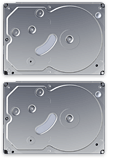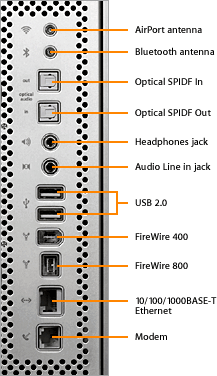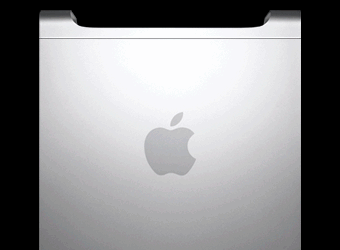A removable side door gives
you access to the slots and bays of the Power Mac G5, so you can add more
memory, a second hard drive or an AirPort Extreme Card quickly and easily
— no tools required.
 Up to 500GB of internal storage
Up to 500GB of internal storage
The Power Mac G5 has two Serial ATA hard drive bays for up to 500GB of
fast internal mass storage — ideal for video, audio and high-resolution graphics.
Built-in software RAID allows you to stripe the two drives for increased
performance or mirror them for high reliability. And it’s easy to add storage
as your needs grow. Single-drive systems come with the cabling to connect
a second hard drive, and the easy-to-open side panel lets you insert a new
drive yourself. Want massive system storage? Just use a Fibre Channel PCI
card to connect to Xserve RAID, Apple’s high-performance storage system.
Up to 8GB of 400MHz DDR SDRAM
 The Power Mac G5 comes with four or eight DIMM slots that use ultrafast
PC2700 or PC3200 DDR SDRAM. This high-speed memory operates at up to 400MHz
for up to 6.4 GBps throughput. Standard configurations come with 256MB or
512MB of RAM. And since memory is scalable up to 8GB, you can add RAM as
your application and workflow requirements increase.
The Power Mac G5 comes with four or eight DIMM slots that use ultrafast
PC2700 or PC3200 DDR SDRAM. This high-speed memory operates at up to 400MHz
for up to 6.4 GBps throughput. Standard configurations come with 256MB or
512MB of RAM. And since memory is scalable up to 8GB, you can add RAM as
your application and workflow requirements increase.
 PCI-X expansion slots
PCI-X expansion slots
PCI and PCI-X cards enable the Power Mac G5 to perform specialized tasks,
such as video acceleration and audio digital signal processing (DSP). PCI-X
supports 3.3V signaling and Universal 33MHz and 66MHz PCI cards. Your built-to-order
Power Mac G5 system can be configured with PCI or PCI-X expansion technology.
Three 64-bit PCI-X slots let you add one card running at 133MHz and two cards
running at 100MHz. Three 32-bit PCI slots allow you to add three 33MHz cards.
FireWire and USB 2.0
 All Power Mac G5 systems have one FireWire 400 port on the front and
one on the back of the enclosure — as well as a next-generation FireWire 800 port on the back — for connecting to
high-bandwidth devices such as DV cameras, hard drives, and digital music
players. You also get two USB 1.1 ports on the keyboard and three USB 2.0
ports — one on the front and two on the back — for connecting to printers,
scanners, graphics tablets, keyboards, microphones, speakers, joysticks and
other industry-standard input and output devices.
All Power Mac G5 systems have one FireWire 400 port on the front and
one on the back of the enclosure — as well as a next-generation FireWire 800 port on the back — for connecting to
high-bandwidth devices such as DV cameras, hard drives, and digital music
players. You also get two USB 1.1 ports on the keyboard and three USB 2.0
ports — one on the front and two on the back — for connecting to printers,
scanners, graphics tablets, keyboards, microphones, speakers, joysticks and
other industry-standard input and output devices.
 Optical digital audio
Optical digital audio
The Power Mac G5 comes with audio capabilities that are not usually found
on personal computers. The state-of-the-art optical digital audio in and
out ports use the S/PDIF (Sony/Philips Digital Interface) protocol over Toslink
cables for connecting to devices such as decks, receivers, digital instruments,
and even 5.1 surround-sound speaker systems.

|

|
 Plugged in
Plugged in
It’s easy to plug printers, scanners and other devices into the Power Mac G5. In addition to sporting a full complement of ports on the back, the front panel has FireWire 400 and USB 2.0 ports, as well as a headphone and speaker minijack.
|
Gigabit Ethernet
Gigabit (10/100/1000BASE-T) Ethernet is built into every Power Mac G5,
and the autosensing port makes it simple to connect to the network.
|
 Go wireless
Go wireless
Wireless networking is equally simple using the optional 54-Mbps AirPort Extreme Card and AirPort Extreme Base Station. The optional Bluetooth module and antenna allow you to connect wirelessly to a range of digital devices like cell phones, PDAs and printers.
|
Analog Audio
The Power Mac G5 also features high-quality, analog stereo audio line
in and line out ports, and a handily-positioned minijack on the front panel
makes it easy to plug in your headphones.
|



